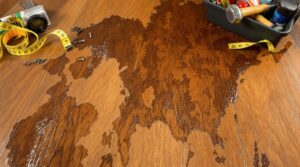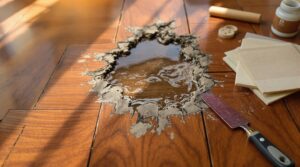When water damage occurs, immediate action is critical. The first step involves shutting off the main water supply and electricity to affected areas. Protective gear should be worn before entering contaminated areas. Quick documentation through photos and videos helps with insurance claims. Professional restoration services must be contacted for proper water extraction and drying. Understanding the full scope of damage and available solutions requires expert consultation for ideal recovery outcomes.
Key Takeaways
- Immediately shut off the main water supply and electricity to affected areas to prevent further damage and electrical hazards.
- Document everything with photos and videos before cleanup, including all damaged items and affected areas for insurance claims.
- Remove standing water using pumps or wet vacuums, then use fans and dehumidifiers to start drying affected areas.
- Contact your insurance company right away and consider hiring a public adjuster to help maximize your claim settlement.
- Seek professional water damage restoration services to properly clean, dry, and prevent mold growth in affected areas.
Understanding Common Causes of Water Damage
While water damage can occur from various sources, several common causes frequently lead to significant property damage in residential settings. Among these causes are leaks from plumbing fixtures, roof leaks, and flooding from heavy rainfall. One particularly concerning issue is water damage on wood floors, which can lead to warping, mold growth, and a complete loss of structural integrity if not addressed promptly. Homeowners should be vigilant and take preventive measures to mitigate these risks, ensuring that their properties remain safe and secure from the harmful effects of moisture.
Leaky or burst pipes, often resulting from freezing temperatures or corrosion, require consistent pipe maintenance and proper insulation in cold areas.
Clogged gutters and downspouts present another significant risk, making regular gutter cleaning essential to prevent water from pooling near foundations. Heavy rainfall accumulation can quickly overwhelm poorly maintained drainage systems, leading to extensive water damage.
Faulty appliances, particularly washing machines, dishwashers, and water heaters, can cause extensive flooding due to worn hoses or deteriorating seals.
Additionally, roof issues such as missing shingles, cracked tiles, or compromised flashing create vulnerabilities where water can penetrate the home's structure.
Regular inspections of roofing materials and prompt repairs are vital for preventing water intrusion, especially in older homes exposed to severe weather conditions.
Emergency Steps After Discovering Water Damage
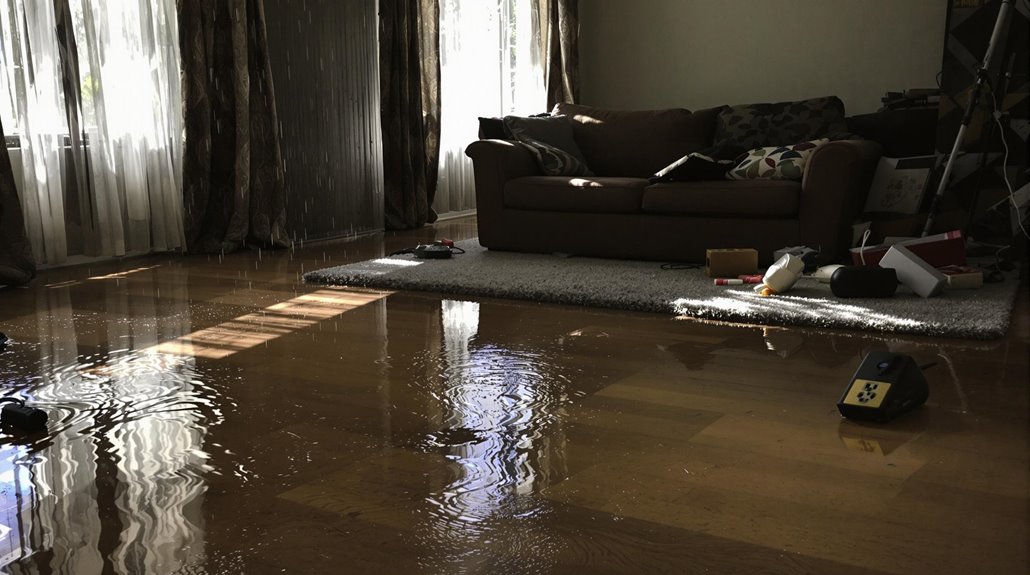
When water damage is discovered in a home, the initial critical steps involve stopping the flow of water and documenting the situation before remediation begins.
Homeowners should immediately locate and shut off the main water supply if the source is plumbing-related, or implement temporary protective measures for external sources like roof leaks. Personal safety is paramount, so remember to switch off power to any affected areas to prevent electrical hazards. Coverage and claims considerations should be reviewed promptly to ensure proper documentation meets insurance requirements.
Before initiating cleanup efforts, thorough photographic documentation and detailed notes about the extent of damage are essential for insurance purposes and proper assessment of the situation.
Stop Water Flow Immediately
Swift action to stop water flow is critical when discovering water damage in a home. The initial phase of damage control requires identifying the source, whether it's burst pipes, leaky appliances, roof damage, sewage backups, or frozen pipes showing signs of ice formation.
Once identified, immediate water shut-off is essential through the main valve or specific fixture shut-offs. Installing automatic shut-off valves and regular testing of these systems can prevent extensive damage. Consider contacting a public insurance adjuster to assist with documenting the initial damage and navigating the claims process.
Containment measures should be implemented using sandbags, tarps for roof leaks, and relocating valuable items to safer areas. Safety remains paramount – electrical power must be disconnected, and protective gear worn when handling potentially contaminated water. It's crucial to wear rubber boots and gloves when entering flood-damaged areas to protect yourself from hazards.
For basement flooding, sump pumps effectively remove accumulated water while avoiding structural hazards like compromised ceilings.
Document Before Taking Action
Before taking any remedial actions, thorough damage documentation is essential for insurance purposes and restoration planning. Property owners should capture detailed photos and videos of all affected areas, including walls, ceilings, floors, and damaged belongings. Document timestamps of when the damage was discovered and create an extensive inventory of affected items with their estimated values.
During the documentation process, safety remains paramount. Individuals should avoid entering flooded areas without proper protective gear and verify electrical power is disconnected to prevent hazards.
The documentation should include the water source, extent of damage, and any visible signs of mold or structural issues.
Insurance importance cannot be overstated, as proper documentation supports claim processing and helps determine appropriate restoration strategies.
Professional assessment may also be necessary to identify hidden damages and potential long-term complications.
Understanding your policy limitations is crucial when documenting water damage, as standard coverage may not reflect current market values or replacement costs.
Safety Precautions and Immediate Response

Taking immediate safety precautions during water damage incidents can prevent life-threatening hazards and minimize property destruction.
The first critical step is disabling all power supplies to affected areas to eliminate electrical hazards. Occupants must wear appropriate safety gear, including waterproof boots and protective gloves, before entering contaminated water.
Initial response requires swift action to stop water flow at its source, typically by shutting off the main water supply if the damage originates internally.
Structural integrity assessment follows, checking for sagging ceilings and swollen materials. Gas appliances require immediate inspection to prevent potential explosions.
Once the area is secured, water removal and drying processes can begin. Professional restoration services should be contacted promptly to guarantee proper remediation and prevent secondary damage from mold growth or compromised building materials.
Maintaining detailed documentation of all water damage is essential since water damage claims can significantly impact your future insurance premiums and coverage limits.
Essential Documentation and Insurance Claims
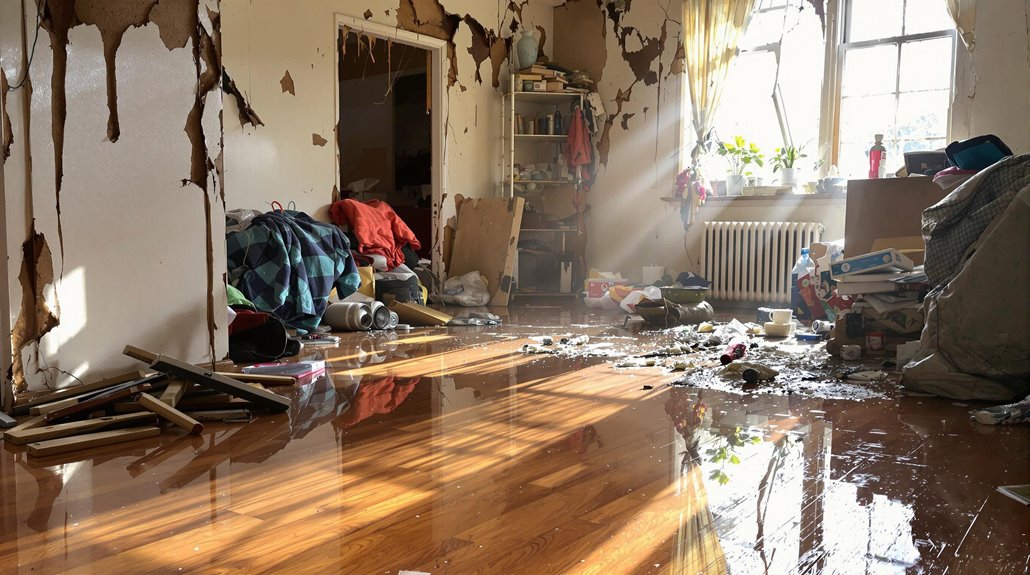
Proper documentation of water damage requires immediate photographic evidence and detailed written records of all affected areas, materials, and belongings.
The insurance claims process necessitates a systematic approach to gathering evidence, including precise documentation of the damage source, timeline of events, and thorough inventory of losses.
Homeowners must maintain organized records of all communications with insurance representatives, contractor estimates, and remediation expenses throughout the claims process.
Consulting with a public insurance adjuster can maximize settlement amounts while providing expert guidance through complex policy terms and documentation requirements.
Document Everything Immediately
Immediate and thorough documentation serves as a critical foundation for successful water damage insurance claims and restoration processes. Extensive photographic evidence and detailed damage assessment records establish the extent of water-related destruction while validating claims with insurance providers.
- Create time-stamped photographs and videos of all affected areas, capturing multiple angles of visible damage and water sources.
- Develop an itemized inventory documenting damaged possessions, including model numbers, serial numbers, and estimated values.
- Maintain a chronological log of all damage-related events, professional services rendered, and communications with insurance representatives.
- Preserve damaged items and collect receipts for temporary repairs, professional assessments, and materials used during the restoration process.
Filing Claims Successfully
Successful insurance claims for water damage require meticulous preparation and strategic execution of the documentation process. Property owners must immediately notify their insurers, understand their coverage limits, and maintain thorough records of all communications with insurance representatives.
The claim process involves creating detailed inventories of damaged items, capturing extensive photographic evidence, and obtaining professional assessments. Homeowners should track claim timelines carefully while collecting receipts for emergency repairs and restoration services.
When meeting with claims adjusters, presenting organized documentation strengthens the case for fair compensation. During settlement negotiations, property owners should review offers thoroughly and compare them against independent contractor estimates.
Understanding policy deductibles and potential rate impacts helps in making informed decisions about pursuing claims and addressing any disputes that may arise.
Professional Restoration and Repair Process
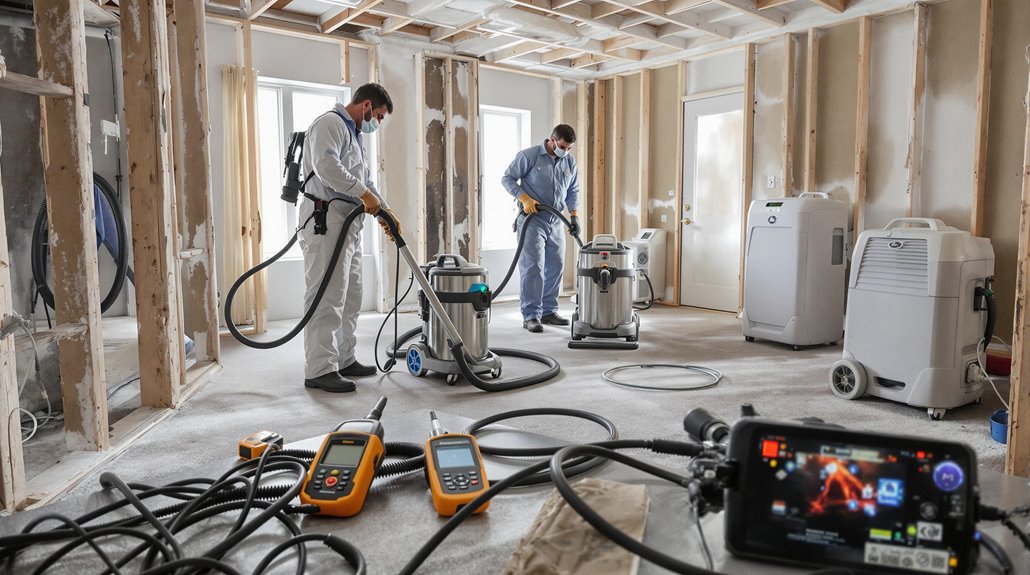
Professional water damage restoration follows a systematic, multi-phase process that begins with a thorough assessment and inspection of the affected area.
Using specialized equipment like moisture meters and infrared cameras, technicians evaluate the extent of damage and develop targeted restoration techniques.
- Initial assessment and documentation, including moisture readings and photographic evidence for insurance purposes
- Water extraction using industrial vacuums and pumps, followed by extensive drying with commercial dehumidifiers
- Thorough cleaning and sanitization of affected areas using professional-grade disinfectants
- Structural repairs and replacement of damaged repair materials, from drywall to flooring
The process concludes with post-restoration monitoring to guarantee complete drying and prevention of secondary issues like mold growth.
This methodical approach guarantees effective restoration while maintaining proper documentation throughout the project.
Prevention Strategies and Long-Term Solutions
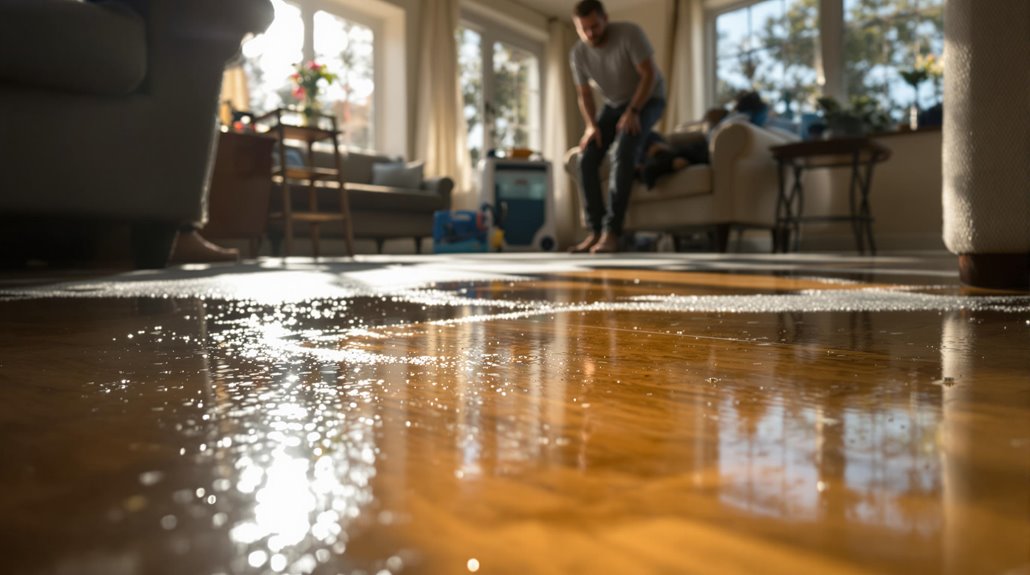
To effectively protect homes from water damage, property owners must implement a thorough set of prevention strategies that address both interior and exterior vulnerabilities.
Exterior preventive measures include proper landscape grading, maintaining gutters and downspouts, and installing effective drainage systems with sump pumps.
Interior maintenance tips focus on regular inspection of water supply lines, utilizing water-resistant building materials, and ensuring adequate ventilation throughout the structure.
Long-term protection requires extensive basement and crawlspace strategies, including waterproofing treatments, foundation inspections, and proper drainage implementation.
Property owners should also maintain HVAC systems, regularly inspect appliances, and install water detection devices in vulnerable areas.
Professional maintenance of trees and vegetation, combined with strategic landscaping choices, further safeguards the property against potential water intrusion and subsequent damage.
The Benefits Of Consulting A Public Adjuster
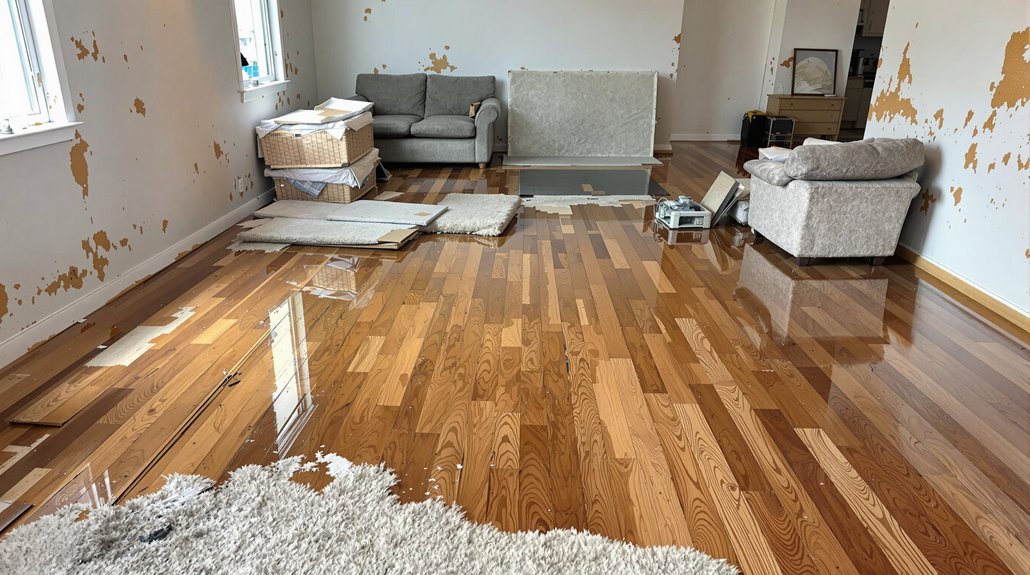
Public adjusters offer specialized expertise in managing complex insurance claims related to water damage, providing objective assessments using professional tools and methodologies.
Their involvement streamlines the claims process through systematic documentation, policy review, and direct communication with insurance companies.
Studies indicate that claims handled by public adjusters often result in considerably higher settlements compared to those filed independently, primarily due to their thorough understanding of policy coverage and ability to identify hidden damages.
Expertise In Insurance Claims
When dealing with water damage insurance claims, consulting a public adjuster offers significant advantages due to their specialized expertise in policy interpretation and claims management.
These professionals possess extensive knowledge of insurance procedures and understand the complex documentation requirements essential for successful claims processing.
- Navigate the claims process efficiently while identifying all applicable coverage options
- Counter insurance company negotiation tactics through strategic advocacy
- Prepare thorough documentation, including damage assessments and proof of loss
- Interpret policy fine print to maximize settlement potential
Public adjusters serve as skilled negotiators who advocate for policyholders' interests, ensuring proper compensation for water damage.
Their meticulous approach to documentation and understanding of insurance company strategies enables them to secure fair settlements while reducing the burden on property owners during an already challenging time.
Objective Damage Assessment
Engaging a public adjuster for water damage assessment provides property owners with an objective, methodical evaluation process that greatly surpasses standard insurance company inspections.
Public adjusters utilize advanced diagnostic tools, including moisture meters and thermal imaging equipment, to conduct extensive damage evaluations that identify both visible and concealed water-related issues.
Their unbiased approach guarantees thorough documentation of all damages, from structural compromises to potential mold growth, while eliminating conflicts of interest that may arise with company adjusters.
Through detailed reporting and expert analysis of insurance policies, public adjusters compile evidence-based assessments that support maximum claim recovery.
This systematic methodology encompasses structural evaluations, moisture mapping, and identification of secondary damages, providing property owners with a complete understanding of their water damage situation.
Streamlined Claim Process
Through collaboration with a public adjuster, property owners benefit from a streamlined insurance claim process that markedly reduces complexity and administrative burden. Public adjusters facilitate efficient communication between policyholders and insurance companies while managing documentation requirements and negotiating settlements.
- Expert navigation of insurance policy terms guarantees thorough coverage assessment and maximizes eligible benefits.
- Professional handling of claim timeline requirements prevents delays and maintains momentum throughout the process.
- Strategic documentation management eliminates errors and strengthens the claim's validity.
- Skilled negotiation tactics counter common insurance company strategies that could limit settlement value.
This systematic approach allows property owners to focus on recovery while the adjuster manages technical aspects, documentation, and communication channels. Ultimately, it expedites the path to fair compensation.
Higher Claim Payouts & Settlements
Public adjusters consistently secure higher claim payouts and settlements compared to policyholder-managed claims, with statistical evidence showing increases ranging from 30% to 700% in final compensation amounts. Their expertise in claim negotiation and settlement maximization stems from thorough damage documentation, policy interpretation, and strategic advocacy during insurance discussions.
| Expertise Area | Settlement Impact |
|---|---|
| Documentation | Enhanced evidence collection increases claim validity |
| Policy Analysis | Identifies maximum coverage entitlements |
| Negotiation Skills | Counters lowball offers effectively |
Through extensive damage evaluation utilizing advanced tools and methodical documentation processes, public adjusters quantify losses accurately. Their understanding of coverage options, combined with skilled negotiation tactics, guarantees policyholders receive settlements that fully address both visible and hidden damages, including structural issues and potential long-term effects of water damage.
About The Public Claims Adjusters Network (PCAN)
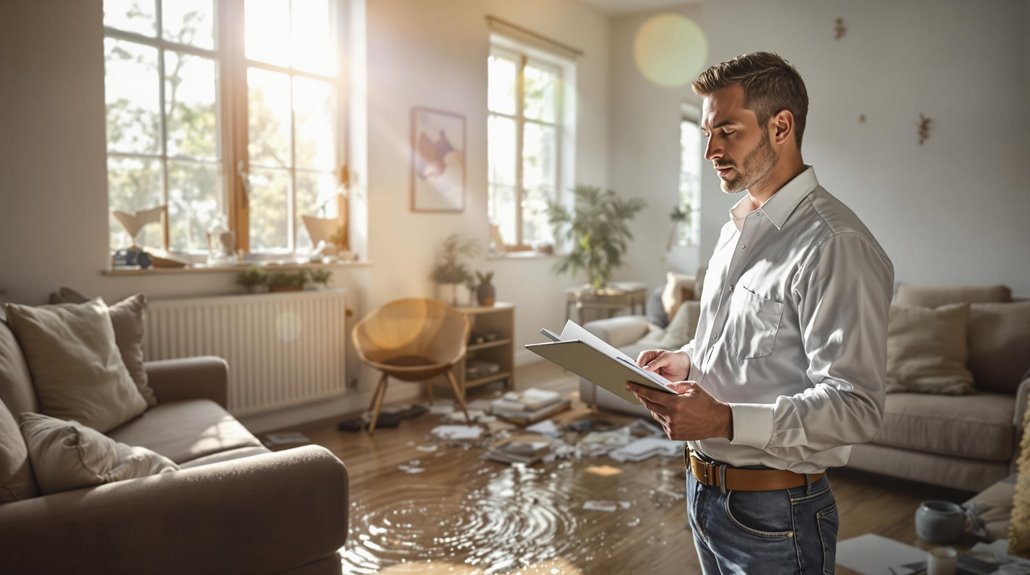
Professional networks like The Public Claims Adjusters Network (PCAN) serve as centralized organizations connecting licensed public adjusters across multiple jurisdictions while maintaining quality standards and ethical practices.
These networks facilitate thorough claims handling through established public adjuster roles and proven claims negotiation strategies.
- Networks provide access to specialized expertise across different claim types, including water damage, fire, and catastrophic loss scenarios.
- Member adjusters must maintain proper state licensure and certifications while adhering to strict professional standards.
- Organizations leverage collective resources and expert testimony to strengthen claim documentation.
- Networks enable coordinated response capabilities for large-scale events through established adjuster deployment protocols.
The structured approach of adjuster networks guarantees policyholders receive consistent, high-quality representation while benefiting from shared knowledge and established best practices across jurisdictions.
Frequently Asked Questions
How Long Does It Typically Take for Water-Damaged Drywall to Dry Completely?
Water-damaged drywall typically requires 3-5 days to dry completely, varying based on implemented drying techniques and ambient moisture levels. Professional equipment and controlled environmental conditions can optimize drying time.
Can I Paint Over Water Stains Without Addressing the Underlying Moisture Issue?
"An ounce of prevention is worth a pound of cure." Painting over water stains without addressing moisture issues negates effective painting techniques and moisture barriers, leading to recurring damage and potential structural deterioration.
Will My Homeowner's Insurance Rates Increase After Filing a Water Damage Claim?
Insurance claims for water damage typically result in 7-10% rate increases, with potential variations based on claim size, location, carrier policies, and prior claims history.
How Can I Detect Hidden Water Damage Behind Tiles or Bathroom Walls?
While amateur sleuths might press ears against walls, professionals employ moisture meters and thermal imaging cameras to detect water intrusion, examining grout lines and conducting systematic tile inspection for discoloration patterns.
What's the Difference Between Gray Water and Black Water Damage?
Gray water from appliances contains mild contaminants, while black water from sewage poses severe health risks due to dangerous pathogens, requiring different levels of professional remediation and safety protocols.
References
- https://rainbowrestores.com/blog/water-damage-statistics
- https://www.coit.com/blog/home-design-repair/water-damage-checklist
- https://www.consumeraffairs.com/homeowners/water-damage-insurance-claims-statistics.html
- https://cfrsfl.com/blog/7-steps-to-take-after-finding-water-damage-in-your-home/
- https://housecashin.com/knowledge-base/water-damage-statistics/
- https://www.servicemasterrestore.com/servicemaster-of-seattle-woodinville/why-us/blog/2024/december/7-most-common-causes-of-residential-water-damage/
- https://www.servicemasterrestore.com/servicemaster-dynamic-cleaning/why-us/blog/2024/april/top-10-causes-of-water-damage-in-the-home/
- https://www.thesilverlining.com/westbendcares/blog/what-are-the-common-causes-of-water-damage
- https://www.searchhomelistings.ca/blog/What-is-Water-Damage–How-Does-it-Affect-Your-House–and-How-Can-You-Fix-It
- https://www.arrowheadgrp.com/blog/most-common-home-water-damage/





